
Created to celebrate Ferrari’s 50th anniversary, the F50 was the closest thing to a road-going Formula 1 car the company had ever built. Given its uncompromising, purist approach to high performance, the F50 was devoid of power steering, power assisted braking and ABS, but made extensive use of sophisticated composite materials, F1-style construction technology and aerodynamics.
In its early days, over 50 years ago, Ferrari built cars which could be used, with only a few minor alterations, for Formula 1 or Sportscar events or everyday on the street. However, as Formula 1 cars evolved, it became impossible for someone who was not a team driver or a collector capable of passing a series of private tests on the track, to take the wheel of a racing Ferrari. Ferrari decided to again give all its clients the chance for this experience. The F50 was the response to this technological challenge. Thanks to the research made possible by Ferrari’s vast experience in this field, producing over 45 racing models and over 120 GT and Sports models, the F50 was built to the same tolerances and with the same integrity as a Formula 1 car. The carbonfiber monocoque that enclosed the aeronautical rubber fuel tank, the V12 engine that acted as a load-bearing structure for the transaxle-rear suspension assembly, the pushrod suspension, and separate hand-braking system are formed on the basic principles of a racing car projected into the dimension of normal, safe use in all situations. The result was a car with a specific power output of 109 HP/litre and an extraordinary chassis that combined unbeatable performance with exact handling and ultimate safety even in unexpected or extraordinary circumstances
The F50 was designed solely for its purpose: there was no styling in the normal sense of the word. The surfaces enveloped the mechanicals in a single sweep from the front air intake to the rear spoiler, volumes were kept to the minimum required by the project. Pininfarina succeeded in designing shapes that recalled the great prototype racers. The strong traits that distinguished the car all have a specific technical motivation: Front bonnet deeply scored by the radiator air vents. Fixed headlights, which are lighter and more aerodynamic. The shape of the front spoiler, rounded at the centre to help the passage of air under the body Very rounded, wraparound windscreen like those of group C prototype cars. Large lateral air intakes to cool the engine bay, enclosed by the underbody fairing Rear spoiler stretching the whole width of the car to balance the negative lift of the underbody. Aerodynamics played an important role from the beginning of the F50 project because: it was a highly advanced car in terms of performance; there was a link between the internal aerodynamic components (cross-flows) and surface layer flows; there needed to be a balance between aerodynamic loads in the dual configuration (Berlinetta and Barchetta) because of the high performance.
The body was built entirely from composite materials with carbon fiber, Kevlar and Nomex honeycomb molded in one of five available colours: red, red Barchetta, yellow, black and grey Nurburgring. On the Berlinetta version, the function of the integral hard top was to complement the structural elements. On the Barchetta version, the bodywork element incorporated the anchor points for two roll hoops. The engine was visible through part of the transparent, vented engine cover. The chassis of the F50 was made entirely of carbon fibre, weighing 225 lbs and offering a torsional rigidity of 25,677 lbs-ft/°. Like a Formula 1 car, occupants sat in the central tub formed by the chassis, and the aeronautical rubber fuel cell was located in a protected position between the passenger tub and the engine and rear suspension. The result was in advanced driving position, with a front to rear weight distribution of 42:58. A load-bearing element, the F50’s engine acted as a support for the suspension, rear bumper and bodywork elements. To guarantee perfect suspension operation, the engine-transaxle assembly was rigidly attached to the chassis.The suspension and engine-gearbox assembly were mounted via low-fatigue light alloy inserts co-polymerized to the chassis. To optimize the structure that made up the fulcrum of the entire system, even from the safety viewpoint, finite element calculation techniques were employed, using programmes that included sandwich elements and multi-ply shells, typical of laminated composite structures. Engineers and designers had to solve problems of the long-term stability of dimensional and structural elements. Tests were carried out on computerized vibration benches.
In keeping with its brief as a Formula 1 car for the street, the F50 employed a naturally aspirated 4.7 liter narrow V12. The block was in nodular cast iron with Nikasil-coated liners. The seven main tri-metallic-bearing crank shaft was propelled by Mahle-forged aluminun pistons via titanium Ti6al4V alloy connecting rods. Lubrication was dry sump with water cooling. The Bosch Motronic 2.7 engine management system combineed electronic injection and static ignition. The cylinder head had five radial valves per cylinder. This is an ideal solution for engines capable of high speeds that close valves pneumatically. The five valves (three intake and two exhaust) were smaller and therefore the flutter speed was raised above 10,000 rpm. A five-valve arrangement makes it possible to achieve a high degree of permeability of the intake ducts. The valves were driven by four overhead camshafts. The intake system was of the variable geometry type. The F50 was fitted with an insulated stainless steel exhaust system. A throttle valve driven by the Motronic control unit made two exhaust system lengths available, one was tuned to achieve the best torque values, the other was tuned for better performance at top speed and full load by reducing the back pressure on the exhaust. The 6-speed longitudunal Ferrari gearbox was designed for short stroke rapid engagement. The synchronizers were ZF twin cone. The gearbox had a manual control with lever, selector fork and rod, and rigid shaft fitted on sliding couplings. The knob was in composite material.The differential was of the limited-slip type, with a differentiated lock percentage in drive and release. The hydraulic actuated clutch was of the dry twin plate type with self-centering thrust bearing. A water-oil heat exchanger kept oil temperature constant. The gearbox housing was made of magnesium alloy
The length of the locating arms was chosen to keep track and camber changes to a minimum. The front and rear suspension had wishbones and reaction arms that act on spring and damper by way of a push-rod system. The dampers were specially developed by Bilstein. To guarantee the setup and maximum precision in wheel movement over the ground, all the joints linking the suspension to the chassis were rigid, as they are on racing cars. On the rear axle, the suspension arms were fixed to an intermediate element between the engine and the gearbox which acts as an oil tank, as it does in Formula 1. The length of the arms improved the contact between the wheels and the ground, considerably reducing sweep and improving roadholding. The hub carriers were made of a special hot-forged aluminum alloy, which increases rigidity and significantly reduces weight.The front track was wider than the rear to promote understeer. The spring and damper control mechanism was linked to an electronic damper control system, managed by ECU based on lateral acceleration, the steering angle and longitudinal acceleration. Great care went into the definition of performance in terms of soft and hard handling. The damping control software processed the information received from a series of sensors mounted in the car. This resulted in the best damping in all conditions to optimize contact between wheel and ground, reducing the variations in ground load. Variations due to acceleration were also controlled by the system that reduced bodyshell movement to stabilize the aerodynamic efficiency and guarantee directional stability. Damping was also varied according to speed, independently of this system, making for greater comfort and improving performance at higher speeds.Cast entirely in aluminum alloy, the steering box of the F50 was the fruit of many years’ cooperation with TRW. Racing achieved its most extraordinary progress in the field of braking. The F50 offered the braking of a racing car with a system designed in cooperation with Brembo to incorporate four cast iron discs splined directly on the aluminum hub. The calipers were in alumimium with four large ground cylinders, like those used on Formula 1. The braking system was sized so that it would not need servo-assistance or ABS. Cooling was guaranteed by dynamic air intakes front and rear. The rear wheel assembly, including Titanium hubs, incorporated a Ferrari Formula 1 patent. This system reduces the number and weight of components, and allows extension of the axle shaft reducing power absorption.The F50’s single-piece Speedline wheels were made of a special magnesium alloy with single-nut central attachment. The choice of a size of 18″x81/2″ at the front and 18″x13″ at the rear, was dictated by the choice of large brake discs and low profile tires. Goodyear designed a special racing-based “Fiorano” tire specifically for the F50 in 245/35ZR18 front, 355/30ZR18 rear.
The interior was designed with efficient functionality, ergonomics, and safety in mind. The multi-sized composite seats were upholstered in Connolly leather and special “transpiring” material. The driving position was fully adjustable, including the pedals – the control pads adjusted to the driver’s shoe size – with an F1-type heelrest. The gear shift was the classic Ferrari unit, with gated selector, lever, and knob all in composite. The rearview mirror was shaped to improve visibility in both roof configurations. All controls were specially designed to guarantee ergonomy, and the environmentally-friendly climate control unit was designed for maximum comfort even when the car is open.For racing use, the car has an FIA standard roll bar and 4-point seat belt attachments. The straight forward instrumentation emulated the system designed for contemporary F1. The instruments were managed entirely by an 8-bit microcomputer. The main LCD display had 130 elements and was lit by electro-luminescent bulbs. The major functions were the rev-counter and mileage counter. A panel of tell-tales was positioned to one side, with numerous ideograms representing various alarm signals. It also included a statistics bank incorporating a crash record that memorizes the various use and mission profile parameters of the car, a function that is similar to the concept of telemetric techniques. The gear engaged was calculated by matching engine rpm to the car speed, and is displayed on the panel.

P ZERO CORSA SYSTEM
For the F50s, Pirelli has created a dedicated new version of its P Zero Corsa System tyre with the “Ferrari F50 – Legacy Tour 2025” logo embossed on the sidewall, a degree of personalisation never seen before on any tyre from the brand with the long letter P. The tyre, available in the sizes 245/35 R18 and 335/30 R18 for the front and rear wheels respectively, is part of the brand’s Collezione line dedicated to some of the most iconic vintage and recent classics in history.
Created by Pirelli in the early 2000s to be the most performance-focused version of its road-going range, the P Zero Corsa System tyre has a specifically designed structure that gives it extraordinary stability at high speeds and when cornering, making it also suitable for track use. This tyre features two different tread designs, with a directional pattern for the front wheels and an asymmetric pattern for the rear, which contribute to minimising aquaplaning. This tyre ensures the same sports performance as the tyre of the time, but with even greater safety and reliability ensured by the use of modern compounds.
Specifications and Features
Production ran from 1995 to 1997 in the chassis number range 101919 to 1107575, whilst a GT1 prototype was also produced but never raced, with a total of three examples being made carrying their own chassis number sequence, 001, 002 and 003. A total of 349 cars were made, with the last car rolling off the production line in July 1997.
|
Dimensions |
|
|
Max. length |
176.4 in |
|
Max. width |
78.2 in |
|
Max. height |
44.1 in |
|
Wheelbase |
101.6 in |
|
Front track |
63.8 in |
|
Rear track |
63.1 in |
|
Weight unladen |
2712 lb |
|
Tubeless radial tires |
|
|
Front |
245/35 ZR 18 |
|
Rear |
335/30 ZR 18 |
|
Rubber fuel tank capacity |
27.7 US gal. |
|
Front brake discs |
14.0 in |
|
Rear brake discs |
13.2 in |
|
Gear Ratios |
|
|
1st |
14/39 |
|
2nd |
19/38 |
|
3rd |
22/35 |
|
4th |
25/33 |
|
5th |
28/31 |
|
6th |
31/28 |
|
Rvs |
17/22/43 |
|
Engine |
|
|
12 cylinders in 65° V / 5 valves per cylinder and 4 overhead camshafts |
|
|
Bore and stroke |
3.35 x 2.72 in |
|
Cylinder capacity |
23.9 cu. in |
|
Total displacement |
286.7 cu. in |
|
Compression ratio |
11.3:1 |
|
Max. power output at 8500 rpm |
513bhp |
|
Peak torque at 6500 rpm |
347lb-ft |
|
Specific power |
109 HP/litre |
|
Bosch static electronic ignition |
|
|
Bosch Motronic 2.7 injection |
|
|
Engine weight |
436.5 lb |
|
Performance |
|
|
Top speed |
202 mph |
|
0 to 60 mile |
3.7 s |
|
Standing mile |
30.3 s |

1996 F50 GT
The F50 was used as the platform for the F50 GT which was designed for the international GT competition class. Three were built with the assistance of Dallara and ATR but the car was developed entirely in-house by Ferrari. Aesthetically, the most notable changes with respect to the road car were an air intake on the roof, a different rear wing with central strut and a rear diffuser. It had the same size engine as the F50, a clutch with carbon-fibre disks and a sequential gearbox. The F50 GT clocked some very impressive speeds at Fiorano but the project was never followed up by Ferrari as it was concentrating most of its energies at the time on its Formula 1 comeback.
Engine
- Type rear, longitudinal 65° V12
- Bore/stroke 85 x 69 mm
- Unitary displacement 391.54 cc
- Total displacement 4698.50 cc
- Compression ratio 11,9:1
- Maximum power 551 kW (750 hp) at 10,500 rpm
- Power per litre 160 hp/l
- Maximum torque 529 Nm (54 kgm) at 7500 rpm
- Valve actuation twin overhead camshafts per bank, five valves per cylinder
- Fuel feed Magneti Marelli electronic injection
- Ignition Magneti Marelli electronic, single spark plug per cylinder
- Lubrication dry sump
- Clutch multi-plate
Chassis
- Frame carbon-fibre monocoque
- Front suspension independent push-rod, unequal-length wishbones, coil springs, gas-filled telescopic shock absorbers
- Rear suspension independent push-rod, unequal-length wishbones, coil springs, gas-filled telescopic shock absorbers
- Brakes discs
- Transmission sequential 6-speed + reverse
- Steering rack-and-pinion
- Fuel tank capacity 100 litres
- Front tyres 27/65 x 18
- Rear tyres 30/70 x 18
Bodywork
- Type two-seater berlinetta
- Length 4578 mm
- Width 1986 mm
- Height 1092 mm
- Wheelbase 2580 mm
- Front track 1620 mm
- Rear track 1594 mm
- Weight 860 kg (dry)
Performance
- Top speed 376 km/h
- Acceleration 0-100 km/h : 2.9 sec
F50 Gallery
Videos



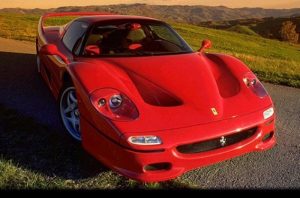
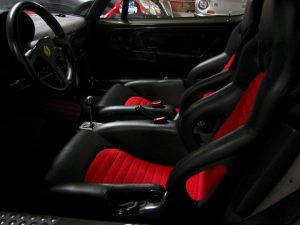

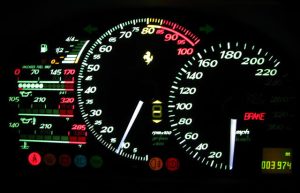

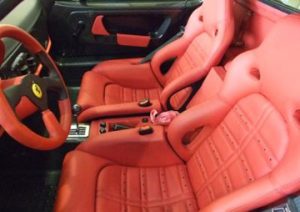



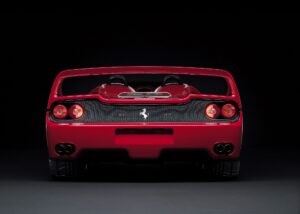
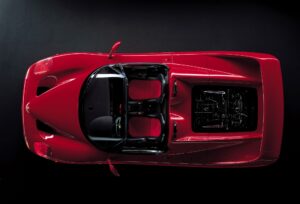

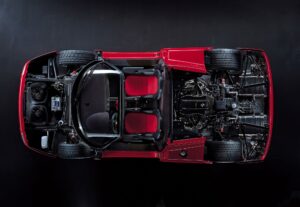




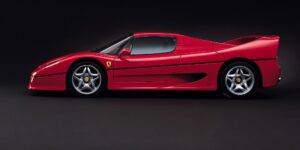
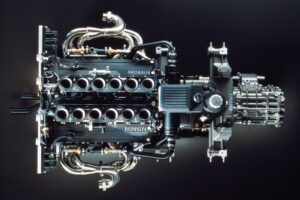
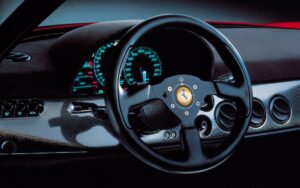

You must be logged in to post a comment.